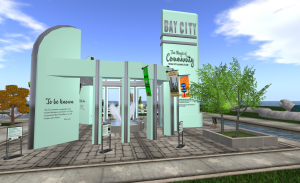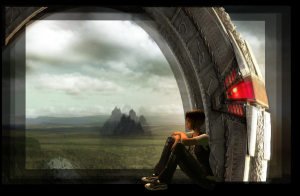After launching a community planning effort in the virtual world of Second Life, I’ve begun to experience a few things I don’t think many of us in government would have thought possible. Like probably many of you working in government and planning, I’ve been amazed that so few people really get involved in a constructive manner in how their city works. There’s been so many council meetings I’ve attended where the only person in the audience was the newspaper reporter and sometimes even he didn’t show up. The planning workshops didn’t attract many more. Yet the Bigfoot show comes to town and everyone shows up at their town hall meeting to passionately share Bigfoot stories!
Unfortunately when people do show up at city meetings, many are usually hesitant to really share or open up. Whether it’s group dynamics or the seemingly heavy hand of government we just seem to receive a more muted response than what is desired. Or like the open forum in a newspaper, it gives people a platform to complain or rant without trying to help find solutions.
Now, I’ve been a member of the Second Life community since late 2006 so I knew enough to not assume the experience there would be the same. But I certainly was not prepared for what has been happening and what it might mean. We’ve started out using a typical planning process with surveys and community meetings. So far we’ve had two meetings in Second Life where where we had roughly 8 or so people show up each time to discuss and share their thoughts about Second Life. And there’s been about 59 surveys filled out. (You can read a summary of the meetings here. The surveys are found here.)
Discovering Outstanding Engagement
What is quickly becoming apparent from the meetings and surveys is that the people who attend and share are focused, open, honest, constructive, understanding, helpful, caring, dedicated, passionate – all those things those of us in government sit on the edge of our seats hoping to see in our planning meetings. I was blown away by the insights and thoughtful statements and observations people made. Even though I’ve spent years there and know the community is amazing, I guess I never saw it expressed in a context I could compare to something I know very well in the offline world. And it got me really thinking and looking into how people here interact for the good of the community.
Constructive, Always-on Community Discussions
I began noticing in a new way all those people in virtual worlds who take the time to share their thoughts online, particularly those in Second Life. This seems to have occurred almost since the creation of that world. So that on any given day, you can find people sharing their ideas and observations about the place on blogs, Twitter, Facebook, etc. And the people taking the time to do this end up creating thoughtful posts with the goal of helping advance our knowledge and success of the community. You can tell they care very much and are invested and passionate about the place. Even when they are analyzing or commenting on a perceived problem, they are also trying to suggest solutions. Then the community jumps in and adds to the discussion. Yes, there might be people in that group who are mad, upset, angry, or exhibiting any other negative emotion. But what typically happens in those cases is the community often reacts and many times ends up creating a constructive discussion out of it.
Have you ever seen this dynamic in an offline community? To the extent it has stretched in Second Life? And in the manner where the people inspire each other in a circular process of sharing, discussing, considering, sometimes acting on an idea, and then sharing again. It’s the engagement those of us in government hope for everyday.
It’s Not Just Second Life
Now, after seeing this, I started wondering why does the engagement and planning process work so wonderfully, well at least so far at this planning stage, in a virtual world, but is so difficult in a traditional setting. And I want to share that I have not just observed this in Second Life. About the same time this planning effort was started, I also began helping a community planning process in another grid. And even though that grid has a much different focus and purpose, we are experiencing the same tremendous level of success with working together for the good of the community.
So What’s the Secret?
I think part of the reason people are better engaged in meetings in virtual worlds could be that the setting prevents them from being influenced by any physical appearances or reactions. It also seems to relieve people about any concerns over what others might think of them or their ideas. They feel safe. Unfortunately in traditional meetings there is always the person who dominates the conversation or people who probably unintentionally end up influencing people’s input. Virtual worlds seem to dampen this and force a type of equalization.
I also wonder if discussions in virtual worlds are more efficient and better focused because discussion can always occur through typing rather than speaking. People can also type privately to each other to discuss what is being said in the public chat which could help them better develop a viewpoint before sharing it publicly.
Or perhaps part of it is that going to a physical meeting is so much more demanding than just logging onto a computer. With the computer, you don’t have to worry about how you’re dressed, you can sit comfortably at home, and if your kids need you or something else comes up, you are available and can always log off.
Are Virtual People More Motivated?
But then I started wondering about the actual people – the people in our traditional meetings are also good, responsible, caring people who have a vested interest in their community. Are they really so different from the people who inhabit virtual worlds as some have suggested? Even Philip Rosedale, the past CEO, touched on this topic. He is quoted as saying, “the problem with creating an immersive 3-D experience is that it is just too involved, and so it’s hard to get people to engage,” he said. “Smart people in rural areas, the handicapped, people looking for companionship, they love it. But you have to be highly motivated to get on and learn to use it.”
Based on the people I have met in Second Life, I’ve not really seen the same limiting demographics he mentions so I can’t really comment on why he chose those specific types of people. But it’s the rest of the quote that is much more interesting to me, particularly as I go through this planning process. He mentions the difficulty of engagement while I see the opposite with people already in Second Life. So I wonder if he is talking about the difficulty of engaging those who are not yet in Second Life. And many of us in Second Life could probably agree with this – it’s extremely difficult to encourage people to join Second Life. But once people are in Second Life and take the time to figure it out, they get it and seem to become highly engaged community members. So does Philip’s last sentence help explain this? Is the ability to be highly motivated and stick with something and learn it the filter that creates a more engaged community? Perhaps these are the type of people who might put self-interest aside and devote their own time to the betterment of a place they love. I am not sure if this is it, but do believe it is something to consider.
And This Means What to Government?
While I’ve been inspired by this deeper, yet far from complete, understanding of the fabric of the Second Life community and virtual worlds in general, I can’t help but wonder how it will impact our offline world. Because I believe at some point it will. And I am not sure if “offliners” are ready for this type of true engagement. Hopefully I’ll get time soon to explore this further in another blog post along with what it could mean to Linden Lab as the creator, host, and manager of our community.



Leave a Reply
You must be logged in to post a comment.